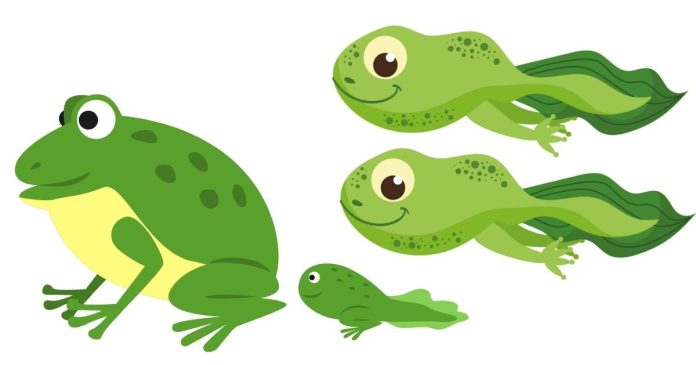The tadpole stage in a frog’s life cycle.
The Life Cycle of a Frog:
- Egg:
- Frogs begin their life as eggs, typically laid in water. The eggs are usually encased in jelly-like substances, and you might see them in clusters or strings, depending on the species.
- Tadpole (Larval Stage):
- After the eggs hatch, the frog’s development enters the tadpole stage. Tadpoles are aquatic, with gills, a tail, and no legs at this point. This is where they look most distinctly different from adult frogs.
Key Characteristics of a Tadpole:
- Gills: Tadpoles have gills that allow them to breathe underwater. These gills are usually external and quite visible on the sides of their head.
- Tail: The tail is used for swimming and is essential for their mobility in water. It helps them propel through the water and navigate their aquatic environment.
- Diet: Tadpoles are typically herbivores at this stage, feeding on algae, plants, and other organic matter found in their aquatic environment.
- Metamorphosis (Transformation):
- Over time, tadpoles undergo a process called metamorphosis, during which they gradually change from aquatic larvae into terrestrial or semi-terrestrial adults.
Metamorphosis Stages:
- Appearance Change: Tadpoles begin to develop hind legs, followed by front legs. At the same time, their tail starts to shrink, and they lose their gills.
- Internal Changes: Internally, the tadpole’s digestive system changes, and the respiratory system transitions from gills to lungs, enabling them to breathe air.
- Dietary Change: During metamorphosis, the tadpole may start eating more animal matter, becoming omnivorous or carnivorous.
- Adult Frog:
- Once the tadpole has fully transformed, it becomes a juvenile frog, which may still have a slightly different appearance from a full-grown adult but is capable of living on land and in water. It will continue to grow and mature, eventually reaching adulthood where it can reproduce.
Tadpole Development Timeline:
- The length of time it takes for a tadpole to become an adult frog varies depending on species, environmental conditions, and temperature, but it usually takes a few weeks to several months. In warmer environments, the process tends to be quicker.
Why Gills and Tail?:
- The gills are crucial in the early stages of a tadpole’s life because they allow the young frog to extract oxygen from water, where it spends most of its time.
- The tail is essential for movement in water and serves as a primary mode of locomotion before the legs fully develop.
In summary, a tadpole is a frog in its early aquatic stage, and during metamorphosis, it gradually transforms into a frog that can live both in water and on land, completing its life cycle.


